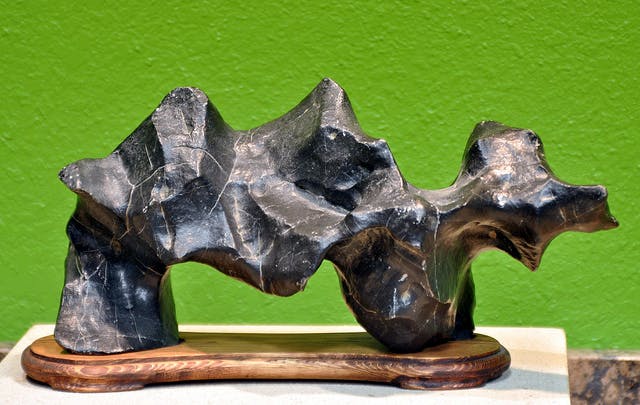Suiseki, Glyptography, and Other Rock Artistry Techniques
Not all creative lapidary work involves cutting gems. Rock artistry techniques like suiseki and glyptography can offer some imaginative possibilities.
3 Minute Read
Indeed, many techniques lend themselves to a simple "do-it-yourself" approach. Take the rather silly, but incredibly successful, Pet Rock fad of the 1970s. (People still buy authentic "vintage" Pet Rocks, at a substantial markup). Some creative types added inexpensive plastic eyes and mouths to create human-like rocks. (Editor's note: More recently, some creative types have added USB cords to Pet Rocks).
Silliness aside, if you want to work with rocks and gems, don't overlook the myriad creative opportunities you may encounter. Let me introduce you to some rock artistry techniques you might be unaware of.
What is Grafting?
Grafting involves combining items that conform to the color and/or texture of a stone''s surface. For example, take a small metal, plastic, or wooden boat and glue it to a sea blue rock slab, such as a section of blue Oregon agate. The color could be natural or dyed. (That won't break any rules).
Take a look at the grafting examples below. Left and center, you have a golfer miniature on a fairway and a horse charm galloping through rocky badlands. On the right, you'll find another approach to grafting. An artisan filled hollows in jasper and fire agate rocks with wax and wicks to produce some marvelous candles.
I once saw a lovely graft consisting of a small metal alloy model of a mountain goat perched precariously on a section of natural rock. That rock looked amazingly like a mountainside. This brings us to our next example of rock artistry techniques.
What is the Japanese Art of Suiseki?
Today, many people all over the world practice the ancient Japanese art of suiseki. This involves appreciating the natural shape of a rock or stone. Practitioners search for, collect, and present stones that evoke other natural forms. Stones that suggest animals, mountains, glaciers, waterfalls, or other organic elements are prized as ways to reflect on nature.
Strict, traditional suiseki followers would never alter the stone in any way. Others, particularly from Western cultures, may plane off a stone's bottom so it will sit flat and fit more conveniently on finished wood or metal bases.
These are my suiseki stones. They represent, from left to right, a mountain goat, a dinosaur, and the Matterhorn mountain.
What is Glyptography?
If your artistic inclinations include drawing or painting, you might enjoy glyptography. This term embraces the work of artists who apply lovely designs to the faces or surfaces of rocks.
These techniques include painting as well as carving or engraving. The designs can range from written messages to abstract or representational images.
Some artists specialize in oil painting mineral slab faces, combining the two elements into a harmonious whole, as shown below.
Fabricating with Gem Materials
Glue together some stones or pieces of crystal into a single entity. Now you have a good example of the time-honored art of gem fabrication. Those small (and expensive) quartz houses you see in curio shops represent fabrication carried to its extreme. While these pretty creations were made from faceted pieces, you can also use rough stones.
See stone and gem fabrication for what it really is. This form of rock artistry has produced pieces such as exquisite Roman mosaics as well as doublet and triplet gemstones. The Hermitage Museum in St. Petersburg, Russia boasts some of the most majestic, and huge, vases. Some were made as mosaics of thousands of small, matching pieces of lapis lazuli and malachite. Cut and matched, jigsaw style, to cover a base construction, these tiny pieces give the impression the vases were cut from single pieces.
Yes, the assemblies discussed above are unique and imaginative. However, the next time you have a chance, look carefully at a stone wall built with irregular pieces of rock. You'll appreciate how these pieces can make an interesting, beautiful whole. Often, the stones fit only approximately, and mortar fills in the spaces. You can apply the same technique on a micro-scale. Some artists used the same method to create elaborate scenes on walls that rival the finest oil pantings.
There's a Rock Artistry Technique to Suit Your Style
Rock artistry can be as simple as gluing sea shells into a pleasant seaside scene or as complex as faceting intricate pieces to fabricate a valuable gem object, such as a flower or statue. You could paint a scene on a mineral slab. You could even take a minimalist suiseki approach and search for a rock that evokes an entire mountain and present it simply.
Just choose the approach you like best and set your imagination free.
Dr. Gerald Wykoff GG CSM
Dr. Gerald Wykoff is GG (Graduate Gemologist), a CSM (Certified Supreme Master gemcutter), educator, and author of several gemology books. He founded the American Society of Gemcutters in the 1980s and served for more than 10 years as the editor of its monthly magazine, American Gemcutter.
Related Articles
Ametrine Facet / Faceting Information
Icon: Faceting Design Diagram
24 Rose: Faceting Design Diagram
Delight: Faceting Design Diagram
Latest Articles
Hambergite Value, Price, and Jewelry Information
Pearl Simulants: How to Spot Faux Pearls
Opal Buying Guide
Amethyst Sources Around the World: The Geological Story Behind These Purple Gemstones
Never Stop Learning
When you join the IGS community, you get trusted diamond & gemstone information when you need it.
Get Gemology Insights
Get started with the International Gem Society’s free guide to gemstone identification. Join our weekly newsletter & get a free copy of the Gem ID Checklist!
